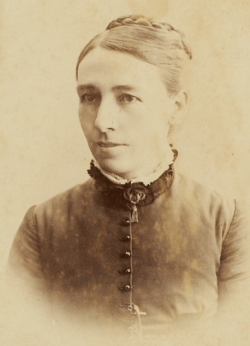
For a number of years while Francis Anderson was Professor of Philosophy at the University of Sydney, he and his wife Maybanke divided their time between Apricot, a ‘picturesque town house’ at 27 Arundel Street, and a larger property at Pittwater, near Bayview Post Office. The Andersons were at number 27 from ca 1910 to 1916. Their predecessors were the Byrne family of horsebreakers, saddlers and curriers. Robert Parkin Elliott Read, a valuer, moved in during 1917.
Maybanke Susannah Selfe (her first name the surname of her great-great -grandfather) landed in Sydney in 1855 with her brothers and parents Henry, a plumber, and Elizabeth, a strong advocate of women’s independence. The family settled in The Rocks. In 1867, the year Maybanke married timber merchant Edmund Wolstenholme, her father drowned in the Nepean River. Other deaths followed. Of Edmund and Maybanke’s seven children, James, Hilda, Norman and Bertha died in infancy, and Arthur aged 23 drowned in a shipwreck. In the 1880s the Wolstenholmes moved from Snails Bay, Balmain, to present-day Dulwich Hill where they built a large home, Maybanke.
In 1884 Edmund, after years of business failures and alcoholism, deserted his family. Maybanke, supported by her brother Norman, a prominent engineer, turned her home into a girls’ school which developed a reputation for academic success. Following her divorce, finalised in 1893, she found renewed vigour in reformist activities.
Already a member of the Women’s Literary Society, the Womanhood Suffrage League, the Australasian Home Reading Union, the International Women’s Union and the Teachers’ Association of NSW, Maybanke edited and published Woman’s Voice, a fortnightly journal covering social issues such as suffrage, sex education and the often desperate conditions of working women, especially single mothers. Her close friends included Mary Windeyer, Rose Scott, Louisa Lawson, Matilda Curnow and Lucinda Gullett. The last two were the wives of the editors of the Sydney Morning Herald and Daily Telegraph respectively – newspapers which covered women’s issues objectively in contrast to the Bulletin which lampooned Maybanke Wolstenholme, later Maybanke Anderson.
The subject of female suffrage sometimes aroused strong feelings; one woman at a literary meeting referred to it as an ‘abominable question’ and chairs were broken during a debate in Newtown Town Hall, but indifference was the usual reaction. Maybanke saw the vote as a tool rather than a weapon and herself as a facilitator rather than a political figure ‘for the simple reason that I think too much valuable time is wasted by politicians in personal quarrels’.
Aware that the children of many working mothers were roaming the streets or locked up in their houses, Maybanke established the Kindergarten Union whose goals were to educate children as well as mind them. While looking for premises she watched a girl being dragged about as part of ‘a queer sort of game’. ‘It’s all right, Missis!’ assured a boy looking on. ‘They’re gammonin’ (pretending) she’s drunk an’ they’re takin’ ‘er orf to the lock-up’. Sydney’s first free kindergarten, in Charles Street Woolloomooloo, opened in 1896. Others followed (Newtown, Miller’s Point, Surry Hills, Wentworth Park, Chippendale, Rozelle and Pyrmont), all within walking distance from the homes of poor inner city residents. A training college for the teachers was established in Liverpool Street Darlinghurst. Maybanke was convinced that the foundation of society was its children, and that the child’s foundation was its mother. In Mother Lore (1919) she wrote that the money spent on gaols and reformatories would be better spent educating mothers through the three Hs: Heart, Hand and Head. It was through her involvement with the Kindergarten Union that she met her second husband, whom she married in 1899.
Francis Anderson trained as a pupilteacher and taught at Glasgow University before migrating to Melbourne in 1886. In 1890 he became Sydney University’s first Challis Professor of logic and mental philosophy. Critical of the pupil-teacher system and the rigidity of curriculum and teaching methods, he adopted the slogan ‘Train the Teacher, Trust the Teacher and Pay the Teacher’ and helped develop what became known in NSW as the New Syllabus, under the direction of Peter Board. Both Francis and Maybanke were strong supporters of the Workers’ Educational Association, active in Australia from 1913.
Following a trip to Europe in 1909, Maybanke founded the Playgrounds Association with the goal of setting up supervised centres in local parks where children could get fresh air and exercise. The Lance Playground in Miller’s Point was the first to open, followed by others in Chippendale, Surry Hills, and Moore and Prince Alfred parks. Many were later run by the Children’s Library and Crafts Movement (in the 1970s renamed the Creative Leisure Movement).
It was during the Andersons’ third overseas trip in 1927 that Maybanke died, in Paris. The following year Francis married Josephine Wight. He was knighted in 1936 and died, childless, at Woollahra. Maybanke’s firstborn, Harry Wolstenholme, became a noted ornithologist.









One comment. Please add yours.
We all need to know about the achievements of Maybanke Anderson – She was amazing.
Thank you Jan Roberts for your brilliant talk about Maybanke at the Mona Vale Library and the book “Maybanke Anderson “
Rae Walker